
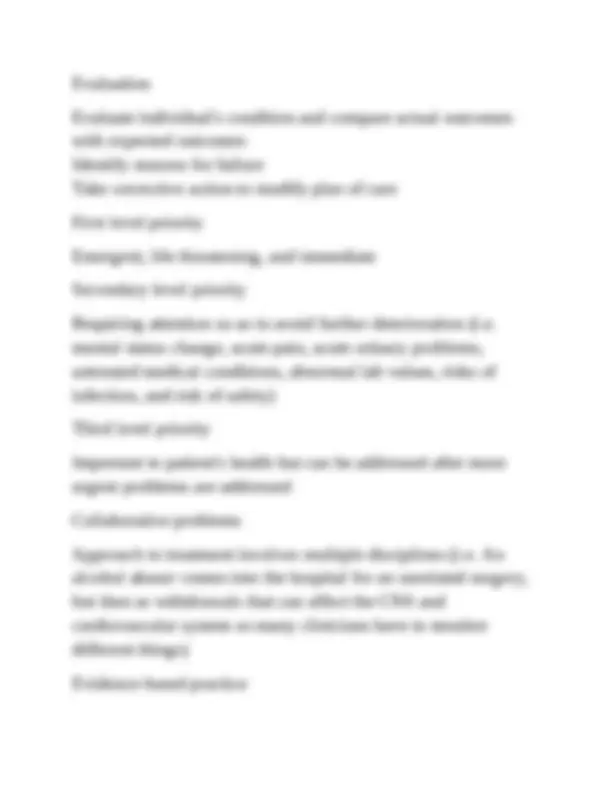
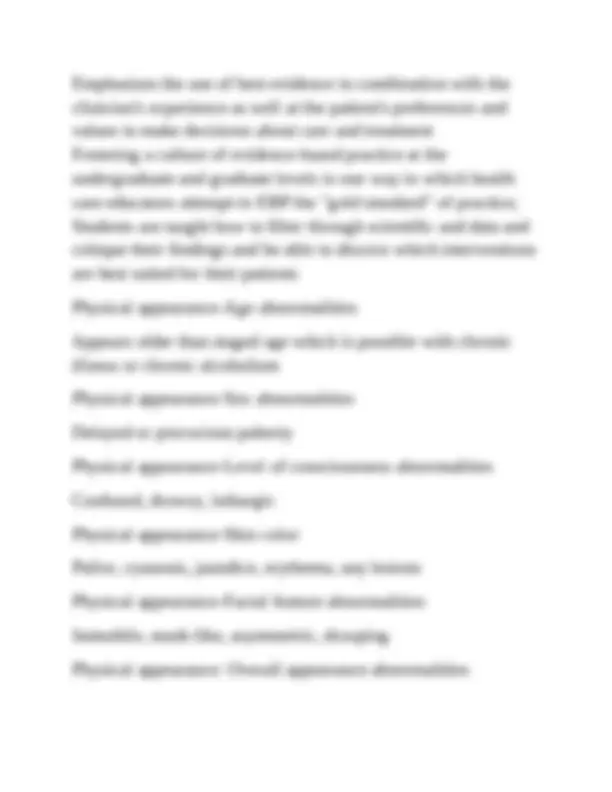
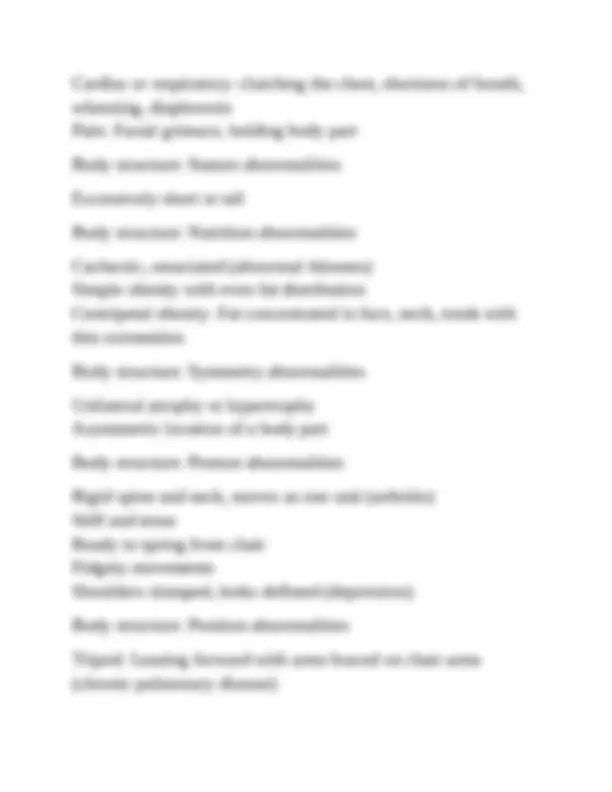
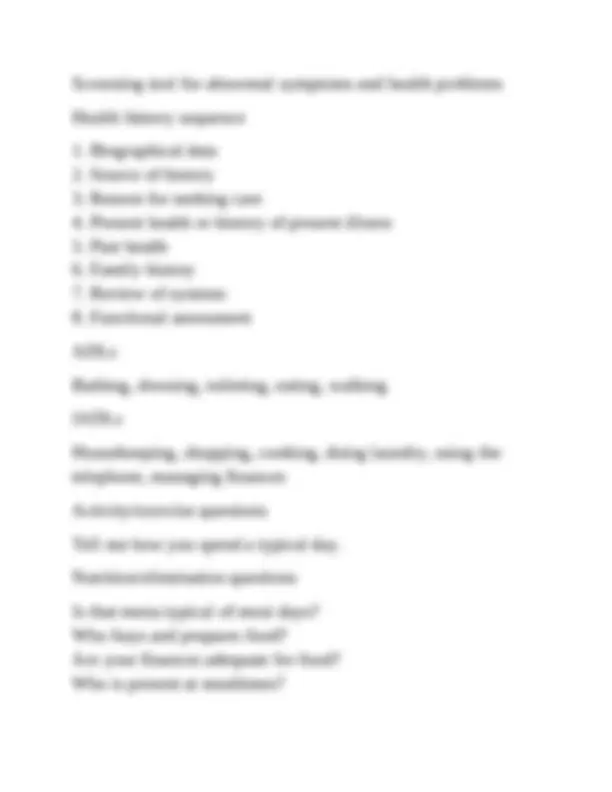
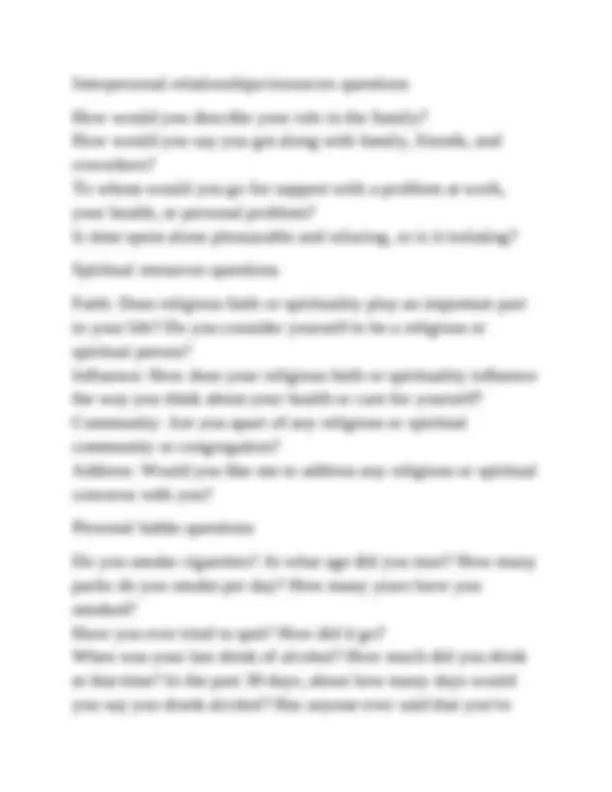
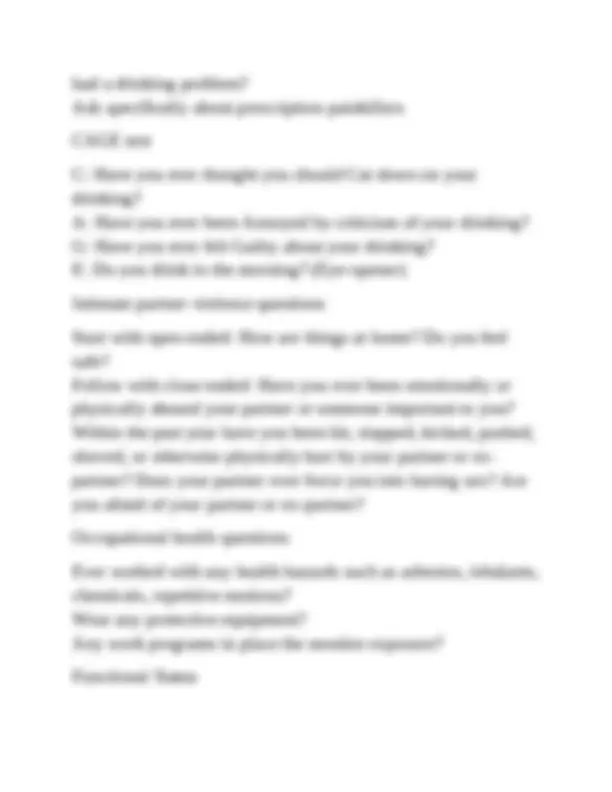
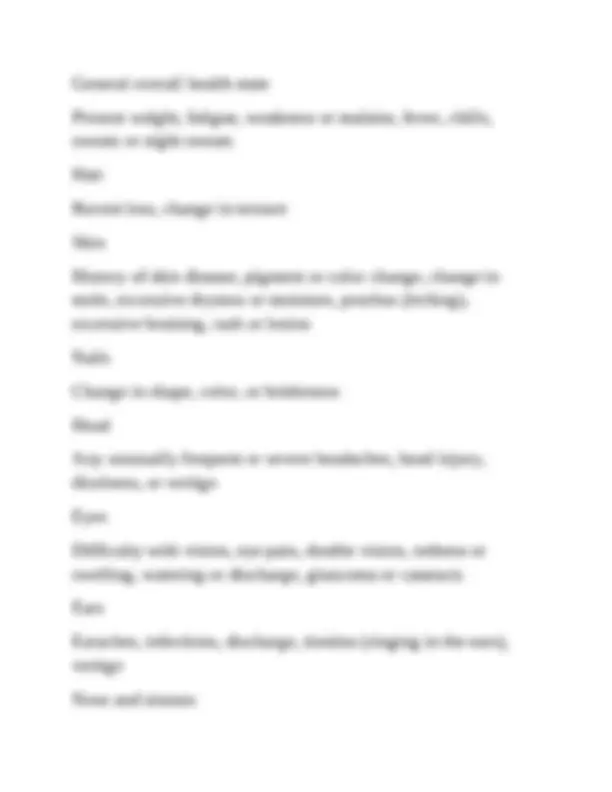
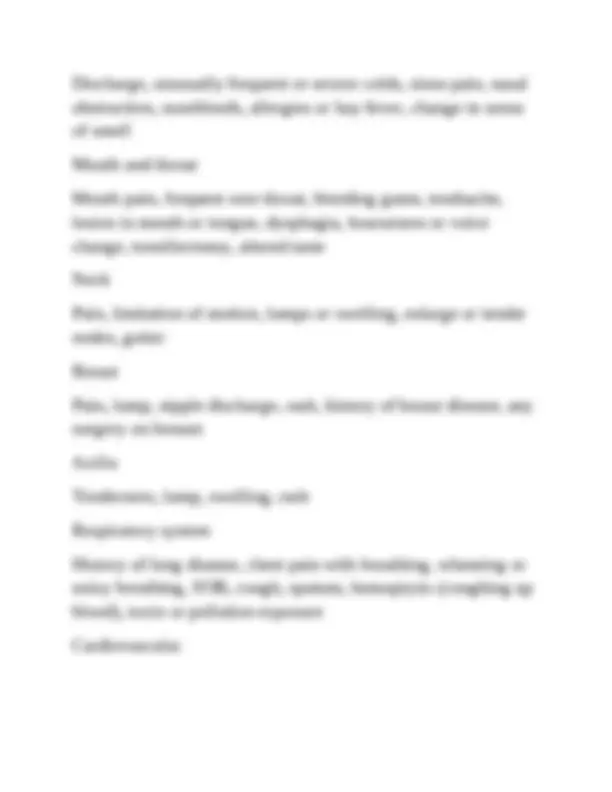
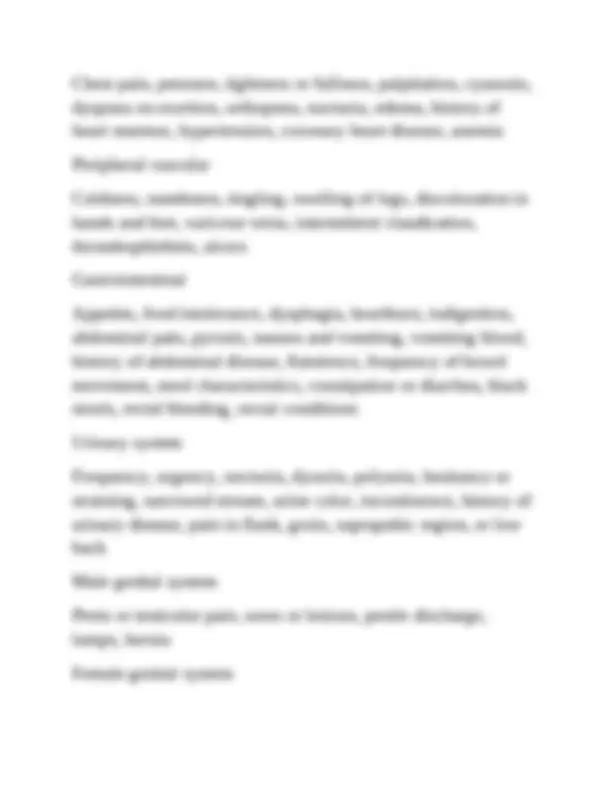

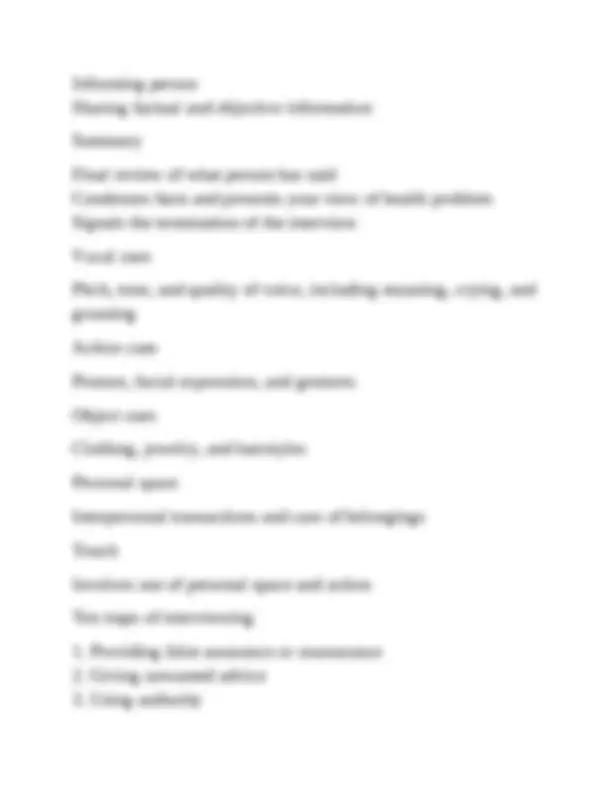
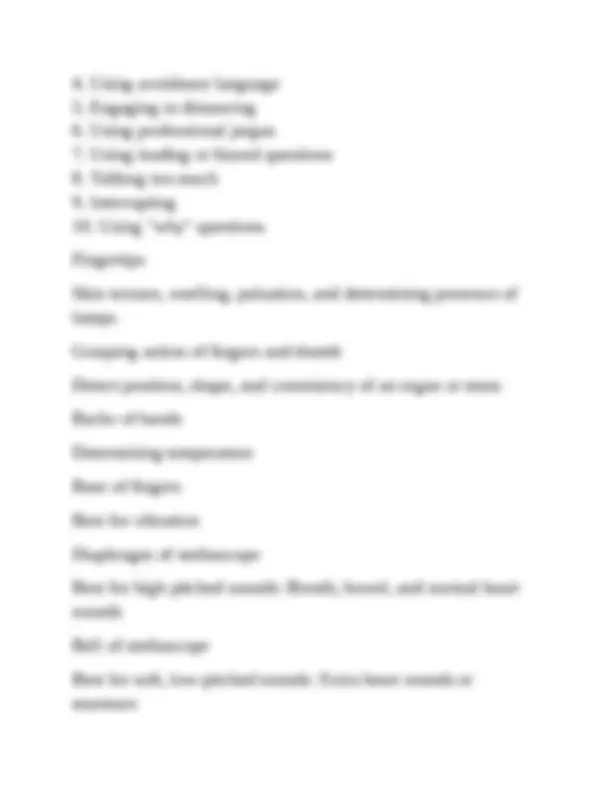
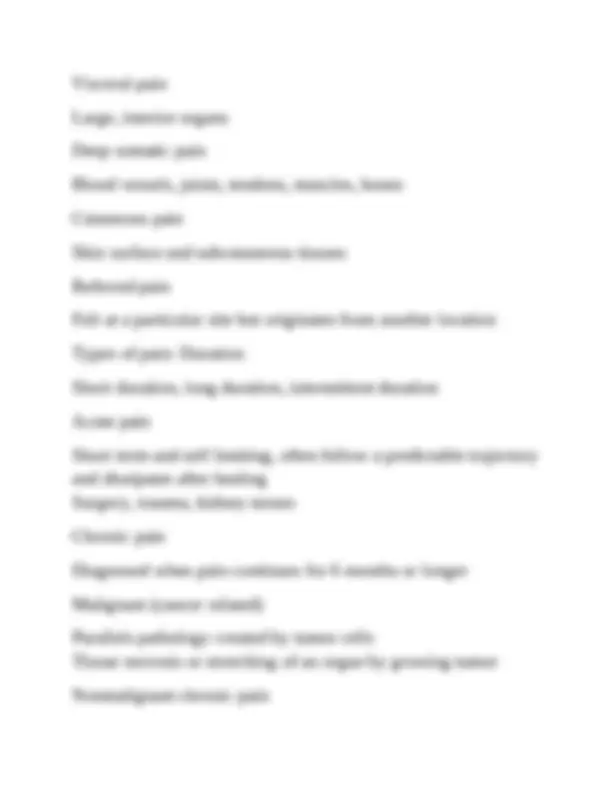
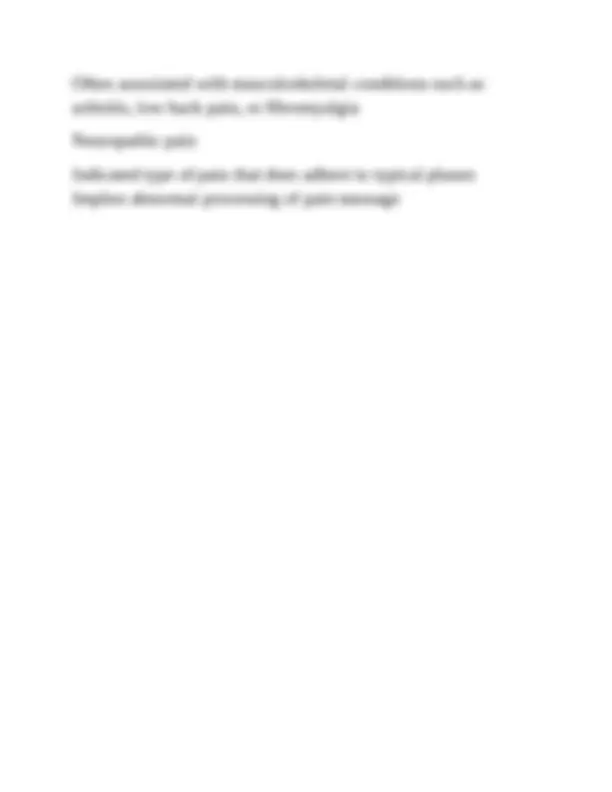


Study with the several resources on Docsity

Earn points by helping other students or get them with a premium plan


Prepare for your exams
Study with the several resources on Docsity

Earn points to download
Earn points by helping other students or get them with a premium plan
Community
Ask the community for help and clear up your study doubts
Discover the best universities in your country according to Docsity users
Free resources
Download our free guides on studying techniques, anxiety management strategies, and thesis advice from Docsity tutors
A comprehensive overview of nursing assessment and health history, covering key concepts, steps, and examples. It includes a detailed breakdown of the nursing process, assessment techniques, and functional assessment tools. The document also explores the importance of evidence-based practice in nursing and provides a framework for understanding and addressing various health concerns.
Typology: Exams
1 / 22

This page cannot be seen from the preview
Don't miss anything!















Complete total health database Includes complete health history and full physical examination Describes current and past health state and forms baseline to measure all future changes Yields diagnoses Episodic or problem-centered database For limited or short term problems Smaller scope and more focused Concerns mainly one problem, complex, or body system History and examination follow direction of presenting concern Follow up database Status of all identified problems should be evaluated at regular intervals Note changes that have occured Evaluate whether a problem is getting better or worse Identify coping strategies being used Emergency database
Rapid collection of data, often compiled currently with lifesaving measures Diagnosis must be rapid and comprehensive Steps of the nursing process Assessment, diagnosis, outcome identification, planning, implementation, evaluation Diagnosis Interpretation of data by identifying clusters of cues so as to make inferences Outcome identifcation Identify expected outcomes related to patient individualization Ensure outcomes are realistic and measurable Specify short-term and long-term goals Planning Establish priorities based on meeting identified patient goals Identify relevant interventions and utilize health care team members Implementation Determine patient readiness and involve patient in health care process Counsel person and significant others Refer for continuing care
Emphasizes the use of best evidence in combination with the clinician's experience as well at the patient's preferences and values to make decisions about care and treatment Fostering a culture of evidence-based practice at the undergraduate and graduate levels is one way in which health care educators attempt to EBP the "gold standard" of practice; Students are taught how to filter through scientific and data and critique their findings and be able to discern which interventions are best suited for their patients Physical appearance-Age abnormalities Appears older than staged age which is possible with chronic illness or chronic alcoholism Physical appearance-Sex abnormalities Delayed or precocious puberty Physical appearance-Level of consciousness abnormalities Confused, drowsy, lethargic Physical appearance-Skin color Pallor, cyanosis, jaundice, erythema, any lesions Physical appearance-Facial feature abnormalities Immobile, mask-like, asymmetric, drooping Physical appearance: Overall appearance abnormalities
Cardiac or respiratory: clutching the chest, shortness of breath, wheezing, diaphoresis Pain: Facial grimace, holding body part Body structure: Stature abnormalities Excessively short or tall Body structure: Nutrition abnormalities Cachectic, emaciated (abnormal thinness) Simple obesity with even fat distribution Centripetal obesity: Fat concentrated in face, neck, trunk with thin extremities Body structure: Symmetry abnormalities Unilateral atrophy or hypertrophy Asymmetric location of a body part Body structure: Posture abnormalities Rigid spine and neck, moves as one unit (arthritis) Stiff and tense Ready to spring from chair Fidgety movements Shoulders slumped, looks deflated (depression) Body structure: Position abnormalities Tripod: Leaning forward with arms braced on chair arms (chronic pulmonary disease)
Dysphagia (difficulty swallowing) Dysarthria (slurred or slow speech that is difficult to understand) Speech defect, monotone, garbled speech Behavior: Speech pattern abnormalities Extremes of few words or constant talking Behavior: Dress abnormalities Clothing too large and held up by belt can indicate weight loss Clothing too tight can indicate obesity or ascites Consistent wear or long sleeves: Concealing needle marks or thin arms (anorexia) Velcro fasteners instead of buttons can mean chronic motor dysfunction Behavior: Personal hygiene abnormalities Body odor, scent of alcohol Unkempt appearance in a person who previously had good hygiene may indicate depression, malaise, or illness Complete health history: Well person Lifestyle, exercise, diet, substance use, risk reduction, health promotion Complete health history: Ill person Information about health problems Complete health history: Everyone
Screening tool for abnormal symptoms and health problems Health history sequence
had a drinking problem? Ask specifically about prescription painkillers CAGE test C: Have you ever thought you should Cut down on your drinking? A: Have you ever been Annoyed by criticism of your drinking? G: Have you ever felt Guilty about your drinking? E: Do you drink in the morning? (Eye-opener) Intimate partner violence questions Start with open ended: How are things at home? Do you feel safe? Follow with close ended: Have you ever been emotionally or physically abused your partner or someone important to you? Within the past year have you been hit, slapped, kicked, pushed, shoved, or otherwise physically hurt by your partner or ex- partner? Does your partner ever force you into having sex? Are you afraid of your partner or ex-partner? Occupational health questions Ever worked with any health hazards such as asbestos, inhalants, chemicals, repetitive motions? Wear any protective equipment? Any work programs in place the monitor exposure? Functional Status
Individual's actual performance of activities and tasks associated with his or her current life roles Dependant on motivation, vision and hearing, degree of assistance needed to accomplish tasks, and cognition Approaches to functional assessment Individual's self report about his or her ability to perform tasks Observing his or her ability to perform tasks Katz Index of Independence in ADL Based on the concept of physical disability and measures physical function in older adults and the chronically ill Activities assessed: Bathing, dressing, toileting, transferring from bed to chair, continence, and feeding Lawton Instrumental Activities of Daily Living Self-report measure of performance rather than ability; Identifies a person's strengths and where assistance is needed Includes: Use of telephone, shopping, meal preparation, housekeeping, laundry, transportation, self-medication, and management of finances AADLs Activities older adults perform as family member, member of society and community, including occupational and recreational activites Self-care, mobility, work, recreational activities, socialization
General overall health state Present weight, fatigue, weakness or malaise, fever, chills, sweats or night sweats Hair Recent loss, change in texture Skin History of skin disease, pigment or color change, change in mole, excessive dryness or moisture, pruritus (itching), excessive bruising, rash or lesion Nails Change in shape, color, or brittleness Head Any unusually frequent or severe headaches, head injury, dizziness, or vertigo Eyes Difficulty with vision, eye pain, double vision, redness or swelling, watering or discharge, glaucoma or cataracts Ears Earaches, infections, discharge, tinnitus (ringing in the ears), vertigo Nose and sinuses
Discharge, unusually frequent or severe colds, sinus pain, nasal obstruction, nosebleeds, allergies or hay fever, change in sense of smell Mouth and throat Mouth pain, frequent sore throat, bleeding gums, toothache, lesion in mouth or tongue, dysphagia, hoarseness or voice change, tonsillectomy, altered taste Neck Pain, limitation of motion, lumps or swelling, enlarge or tender nodes, goiter Breast Pain, lump, nipple discharge, rash, history of breast disease, any surgery on breasts Axilla Tenderness, lump, swelling, rash Respiratory system History of lung disease, chest pain with breathing, wheezing or noisy breathing, SOB, cough, sputum, hemoptysis (coughing up blood), toxin or pollution exposure Cardiovascular
Menstrual history, vaginal itching, discharge, age at menopause, menopausal signs or symptoms, postmenopausal bleeding Musculoskeletal system History or arthritis or gout Joints: Pain, stiffness, swelling deformity, limitation of motion, noise with joint motion Muscles: Muscle pain, cramps, weakness, gait problems, problems with coordinated activities Back: Pain, stiffness, limitation of motion, history of back pain or disk disease Neurologic system History of seizure disorder, stroke, fainting, blackouts, weakness, tremor, paralysis, coordination problems, numbness, tingling, memory disorder, nervousness, mood change, depression, history of mental dysfunction or hallucinations Hematologic system Bleeding tendency of skin or mucous membranes, excessive bruising, lymph node swelling, exposure to toxic agents or radiation, blood transfusion and reactions Endocrine system History of diabetes or diabetic symptoms, history of thyroid disease, intolerance to heat and cold, change in skin pigmentation or texture, excessive sweating, relationship
between appetite and weight, abnormal hair distribution, nervousness, tremors, and need for hormone therapy Interview contract Time and place of the interview and a brief explanation of your role The purpose of the interview How long it will take Expectation or participation for each person Presence of any other people Confidentiality Any costs to the client Sending Not only being aware of verbal communication, but also being aware of nonverbal communication as it can usually be an indicator of your true feelings Receiving You have a specific context in mind when you send your words, but your context may not be understood by the receiver because they have their own interpretations of meaning; Interpretations are based on past experiences, culture, and self-concept Disadvantages of note taking Breaks eye contact too often Shifts your attention away from this person, diminishing his or
Informing person Sharing factual and objective information Summary Final review of what person has said Condenses facts and presents your view of health problem Signals the termination of the interview Vocal cues Pitch, tone, and quality of voice, including moaning, crying, and groaning Action cues Posture, facial expression, and gestures Object cues Clothing, jewelry, and hairstyles Personal space Interpersonal transactions and care of belongings Touch Involves use of personal space and action Ten traps of interviewing